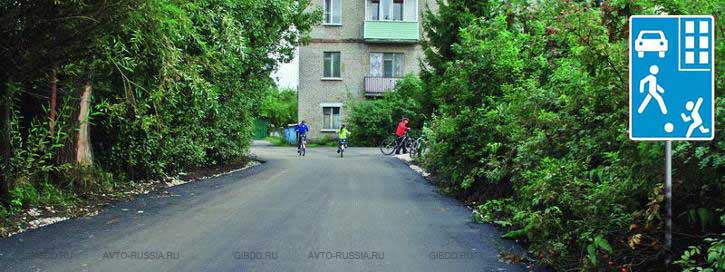Which of the following signs prohibit movement?
Question 79
Which of the following signs are used to indicate the boundaries of an artificial roughness? 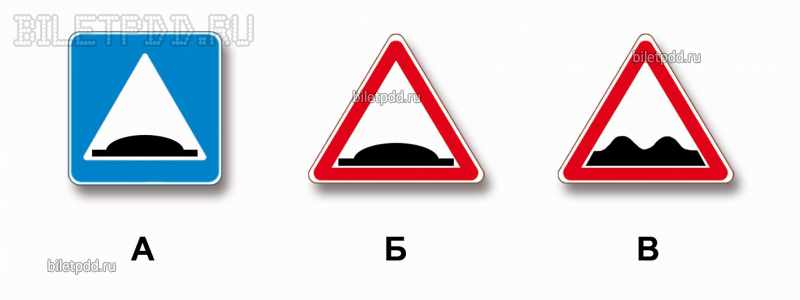
- 1. Only A. 2. Only B.3. B and V.
Signs A and B have the same name " Artificial hump", however, they are installed in different ways. Sign B (1.17) is installed in advance, in populated areas at a distance of 50-100 m from the unevenness, and sign A (5.20) means the boundary of the artificial unevenness. The correct answer is Only A.
Question 80
In the area covered by this sign, stopping is permitted: 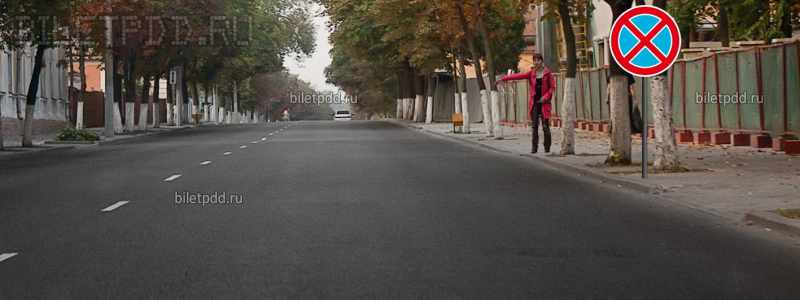
- 1. Route vehicles. 2. Taxi with the taximeter turned on.3. Cars driven by disabled people of groups I and II or transporting such disabled people.
The only type of vehicles that are not covered by sign 3.27 “Stopping is prohibited” are route vehicles, which can stop at designated stopping places within the sign’s coverage area.
Road signs, Part 5:
Take the test
Question 81
By driving which car can you get ahead in this situation? 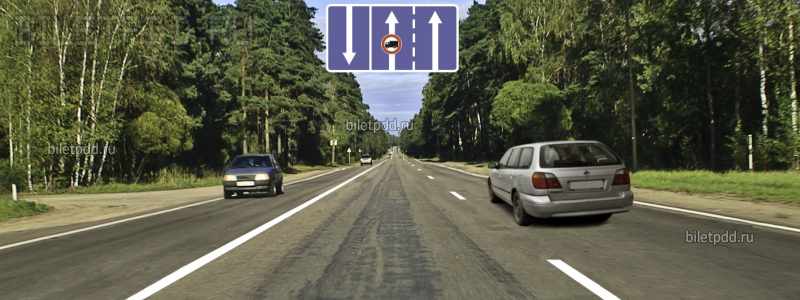
- 1. Passenger cars only.2. Passenger cars or trucks with a permissible maximum weight of no more than 2.5 tons.
- 3. Cars or trucks with a permissible maximum weight of no more than 3.5 tons.
The arrow indicating the direction of movement in the left lane shows sign 3.4 “Trucks are prohibited”, which prohibits movement in this lane trucks with a permissible maximum weight of more than 3.5 tons. Therefore, you can only use the left lane to advance with a passenger car or a truck with a permissible maximum weight of less than 3.5 tons.
Question 82
You can continue moving: 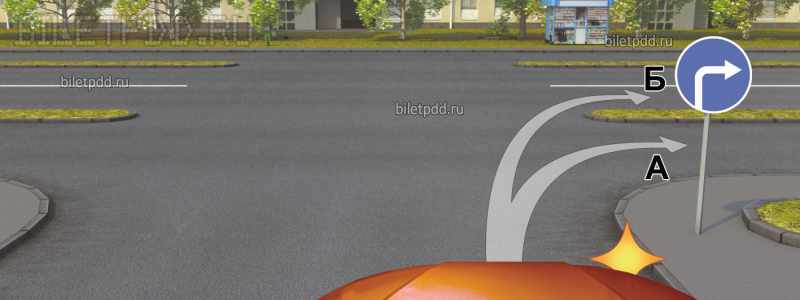
- 1. Only along trajectory A. 2. Only along trajectory B.3. Along any trajectory from those indicated.
At this intersection, the road being crossed has three carriageways. Sign 4.1.2 “Move to the right” applies only to the first intersection of roadways in front of which it is installed, ordering all vehicles to turn right onto the first roadway, i.e. only along trajectory A.
Question 83
At what maximum speed do you have the right to continue driving a truck with a permissible maximum weight of not more than 3.5 tons? 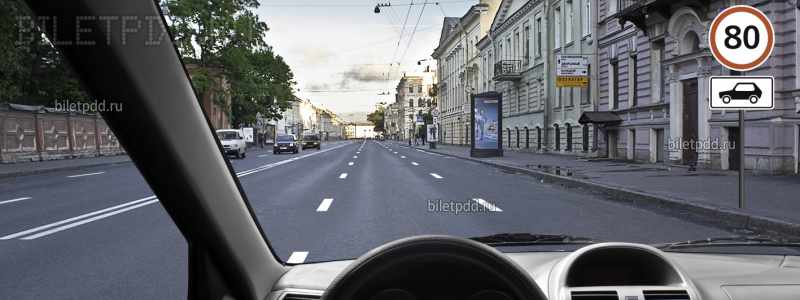
- 1. 60 km/h.2. 70 km/h.
- 3. 80 km/h.
Plate 8.4.3 “Type of vehicle” with a picture of a passenger car also applies the sign to trucks with a permissible maximum weight of up to 3.5 tons. Thus, you can drive at a speed of no more than 80 km/h.
Question 84
Which of the following signs are used to indicate the number assigned to the road (route)? 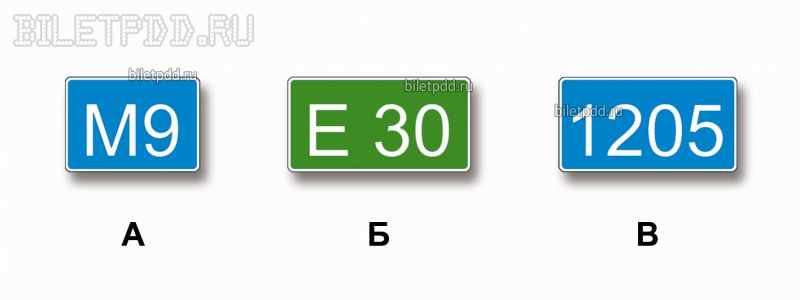
- 1. Only A.2. Only B.
- 3. A and B. 4. Everything.
To indicate the number assigned to a road or route, signs 6.14.1 “Route number” (A and B) are used. Moreover, when installed on motorways and roads included in the European road system (letter "E"), they always have green background. The signs are repeated after 15-20 km. Sign B (6.13 "Kilometer sign") shows the distance to the beginning or end of the road (in kilometers) and is installed after 1 km. The correct answer is A and B only.
Question 85
Which of the following signs provide the right of way at uncontrolled intersections? 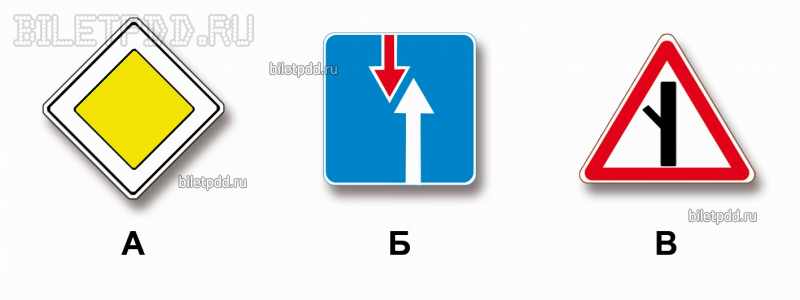
- 1. Only A.
- 2. A and B. 3. Everything.
Advantage when driving through uncontrolled intersections is provided by signs indicating the main road: signs 2.1 “Main Road” (A) and 2.3.3 “Adjunction of a Secondary Road” (B) (clause 1.2, term “Main Road”). Sign 2.7 “Take advantage of oncoming traffic” (B) is used on narrow sections of roads where oncoming traffic is difficult to pass. The correct answer is A and B.
Question 86
Are you allowed to overtake? 
- 1. Allowed. 2. Allowed if the motorcycle speed is no more than 30 km/h.3. Forbidden.
Sign 3.20 “Overtaking is prohibited” allows overtaking in its coverage area of two-wheeled motorcycles without sidecars, as well as mopeds, horse-drawn carts and slow-moving vehicles. This change came into effect on November 20, 2010.
Question 87
Is it possible for the driver to park the truck in this location using the specified method? 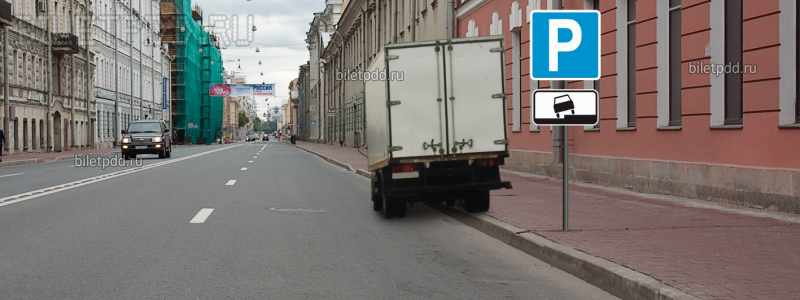
- 1. You can.2. It is possible if the permissible maximum weight of the vehicle is no more than 3.5 tons.
- 3. It is impossible.
Sign 6.4 “Parking Place” with plate 8.6.2 “Method of parking a vehicle” and clause 12.2 of the Rules prohibit any trucks from using the edge of the sidewalk for parking.
Question 88
You can perform a reversal: 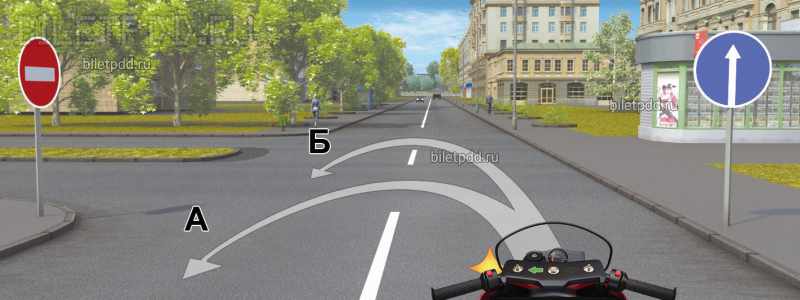
- 1. Only along trajectory A.
- 2. Only along trajectory B. 3. Along any trajectory from those indicated.
The road adjacent to the left has two carriageways, and the sign 4.1.1 “Move straight ahead” applies only to the first intersection of the carriageways in front of which it is installed, prohibiting left turns and U-turns here, and at the second intersection there are no restrictions on maneuvers, and here You can turn around (trajectory B). Correct answer - Only according to B.
Question 89
Are you allowed to park your car in this place on odd days of the month? 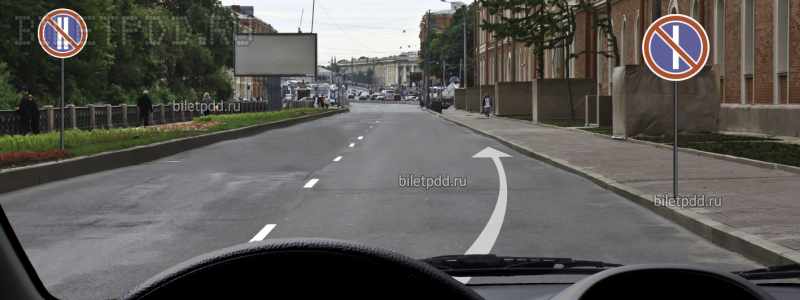
- 1. Allowed.
- 2. Allowed only after 19 hours. 3. Prohibited.
The coverage area of sign 3.29 “Parking is prohibited on odd days of the month” extends to the nearest intersection, therefore, parking your vehicle in the indicated location on odd days of the month is prohibited. However, if signs 3.29 and 3.30 “Parking is prohibited on even days of the month” are installed simultaneously, these signs are valid only until 19:00. Therefore, you can park your car after 19:00.
Question 90
Which of the following signs indicate areas where the driver is required to give way to pedestrians on the roadway? 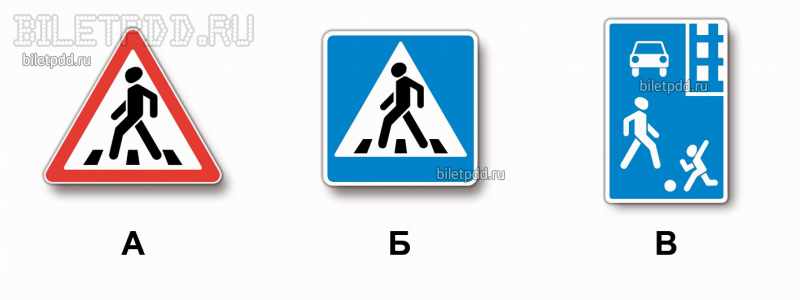
- 1. Only B.
- 2. B and V. 3. Everything.
Sections of roads on which the Rules give priority to pedestrians and oblige drivers to give way to them are indicated by signs B (5.19.1 “Pedestrian crossing”) and B (5.21 “Residential zone”). And if the width of the pedestrian crossing is measured in several meters, then the residential area may include an entire residential area, on the streets and passages of which drivers must be guided by a number of special requirements of paragraphs. 17.1-17.4 Regulations. Sign A (1.22 “Pedestrian Crossing”) only warns the driver about a designated pedestrian crossing on the road, usually outside the intersection and does not put forward specific requirements (Appendix 1). The correct answer is B and C only.
Question 91
Which of the following signs informs you that you are approaching the beginning of a section of road with oncoming traffic? 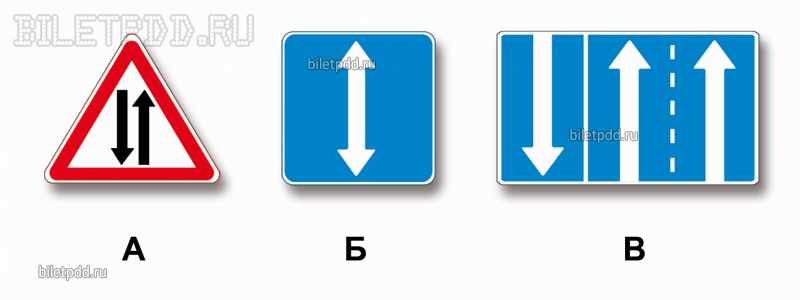
- 1. Only A. 2. A and B.3. All.
When approaching the beginning of a section of road with oncoming traffic, you are informed by sign A (1.21 “Two-way traffic”), which is installed in front of a section of a road (carriageway) with two-way traffic if it is preceded by a section with one way traffic. Sign B (5.8 "Reverse traffic") shows the beginning of a section of the road on which one or more lanes of traffic can change its direction to the opposite, and sign B (5.15.1 "Direction of traffic along lanes") is used when organizing traffic in one direction on two lanes of a three-lane road. The correct answer is Only A.
Question 92
Are you allowed to drive to your place of work located within the coverage area of these signs? 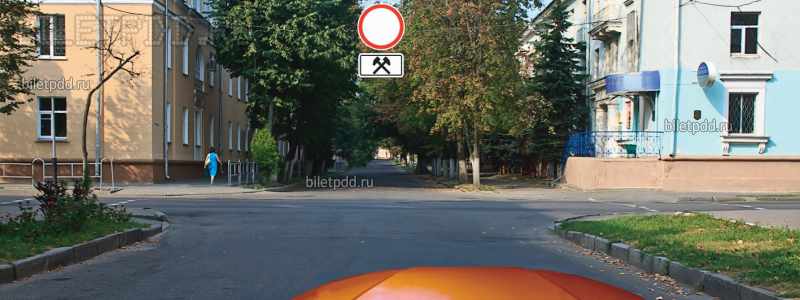
- 1. Allowed. 2. Allowed only on weekdays.3. Allowed only on non-working days.4. Forbidden.
Plaque 8.5.2 “Working days” informs that sign 3.2 “No movement” is valid only on weekdays. However, sign 3.2 does not apply to vehicles of citizens who live or work in the designated area. Thus, you can drive up to your place of work any day.
Question 93
What does this inform you about? road sign with a yellow background? 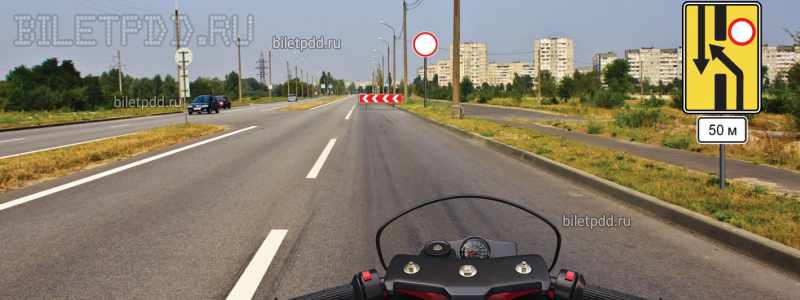
- 1. Further movement is possible only in the second lane.
- 2. Further movement is only possible along the carriageway in the opposite direction. 3. Further movement is possible only on another road.
Sign 6.19.1 “Preliminary indicator for changing lanes onto another carriageway” is used during repair work on roads with a dividing strip, when one of the carriageways is completely closed and vehicle traffic is transferred to the carriageway intended for oncoming traffic. The sign informs you about the location of the gap in the dividing strip, along which you move to the left carriageway.
Ticket 12 - Question 1
In what cases can the owner of a car transfer control of it? vehicle in your presence to another person, having an appropriate insurance policy?
1. If this person has driver's license for the right to drive a vehicle of subcategory “B1”.
2. If this person has a driver’s license for the right to drive a category “B” vehicle.
3. In both of the above cases.
According to Federal law"About safety traffic“(Clause 1, Article 25) the owner of a passenger car, having an appropriate insurance policy, can transfer control in his presence to another person who has a driver’s license for the right to drive a category “B” vehicle (clauses 2.1.1 and 2.7).
Correct answer:
If this person has a driver’s license to drive a category “B” vehicle.
Ticket 12 - Question 2
1. Warns you about availability narrow section roads, but does not establish the order of movement.
3. Obliges you to give way to oncoming traffic.
Correct answer:
The signal is given to attract the attention of traffic participants.
Ticket 12 - Question 7
You intend to turn left at this intersection. At what point should the left turn signals be turned on?
1. In advance, before entering the intersection.
2. After entering the first intersection of roadways.
3. At your discretion.
In this situation, left turn indicators should be turned on only after entering the first intersection of roadways, since turning them on before entering the intersection may indicate your intention to make a U-turn at the first intersection of roadways (clause 8.2).
Correct answer:
After entering the first intersection of roadways.
Ticket 12 - Question 8
Who must give way when changing lanes at the same time?
1. Driver of a passenger car.
2. Motorcycle driver.
3. In this situation, drivers should act by mutual agreement.
When changing lanes at the same time, the driver of a passenger car must give way to the motorcycle on his right (clause 8.4).
Correct answer:
Driver of a car.
Ticket 12 - Question 9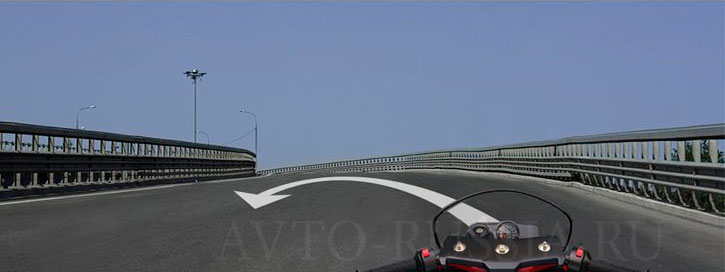
Are you allowed to make a U-turn on the bridge along the specified trajectory?
1. Allowed.
2. Permitted only when road visibility is at least 100 m.
Correct answer:
Forbidden.
Ticket 12 - Question 10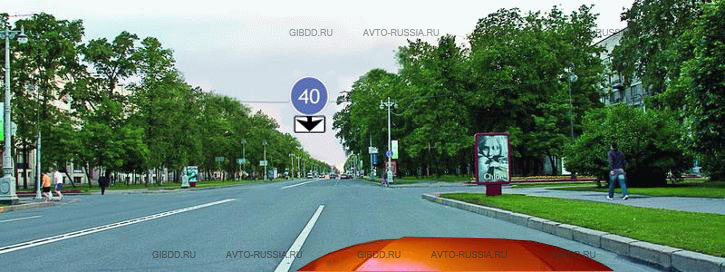
At what speed do you have the right to continue driving in a populated area in the right lane?
1. No more than 40 km/h.
2. No more than 60 km/h.
3. Not less than 40 km/h and not more than 60 km/h.
Correct answer:
No more than 60 km/h.
Ticket 12 - Question 11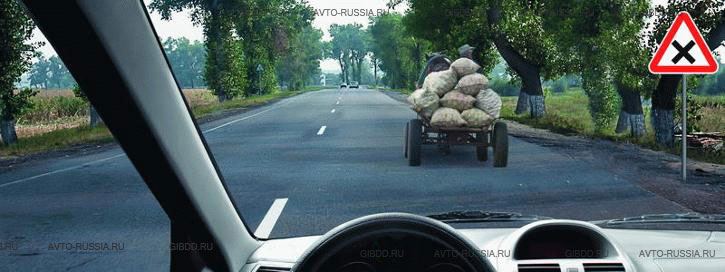
Are you allowed to overtake in this situation?
1. Allowed.
2. Permitted if overtaking is completed before the intersection.
You are approaching an unregulated intersection of equivalent roads (sign 1.6 “Intersection of equivalent roads”). On unregulated intersections overtaking is prohibited when driving on a road that is not the main one (clause 11.4). Therefore, in this situation, overtaking a horse-drawn cart can only begin if it is completed before the intersection.
Correct answer:
Permitted if overtaking is completed before the intersection.
Ticket 12 - Question 12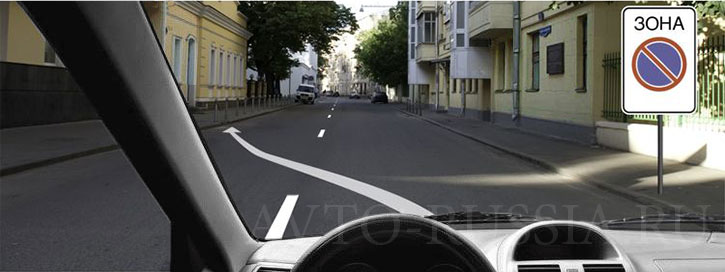
Can you park your car at the specified location?
2. Yes, if you live or work in the area indicated by the sign.
3. It is impossible.
You would have the right to park your car in a populated area on the left side of the road with one lane for each direction in the absence of sign 5.27 “Zone with parking restrictions” (clause 12.1). This sign, in contrast to the prohibitory sign 3.28 “Parking prohibited,” extends its effect not only to the side of the road on which it is installed, but also to the entire territory (road section) until leaving the zone indicated by sign 5.28 “End of the zone with limited parking "(Appendix 1).
Correct answer:
It is forbidden.
Ticket 12 - Question 13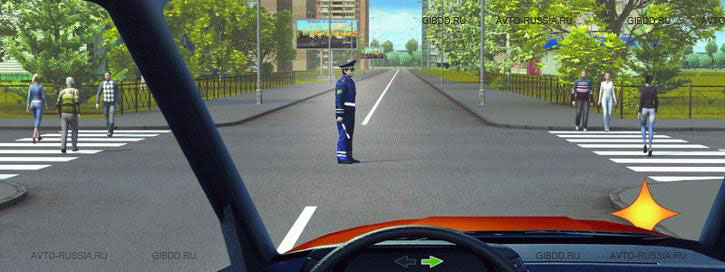
You intend to turn right. What are your actions?
1. Turn right without giving way to pedestrians.
2. Turn right, giving way to pedestrians.
3. Stop before the intersection and wait for another signal from the traffic controller.
In the case when the traffic controller is located towards you with his left or right side, and his arms are lowered or extended to the sides, movement is allowed straight and to the right (clause 6.10). However, when turning right, you should give way to pedestrians crossing the roadway you are turning onto (clause 13.1).
Correct answer:
Turn right, giving way to pedestrians.
Ticket 12 - Question 14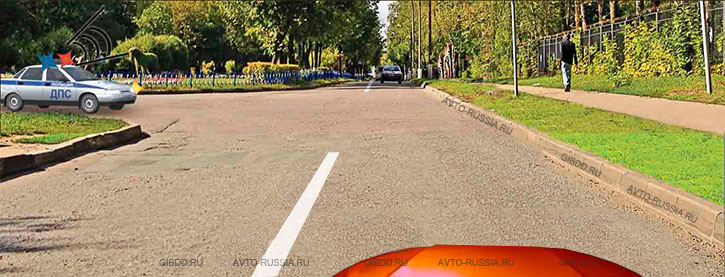
When driving in which direction should you give way to a car with a flashing light and a special sound signal on?
1. Only to the left.
2. To the left and in the opposite direction.
3. In any.
When driving in any direction, you must give way to a passenger car with a flashing light on. blue and a special sound signal (clause 3.2).
Correct answer:
In any case.
Ticket 12 - Question 15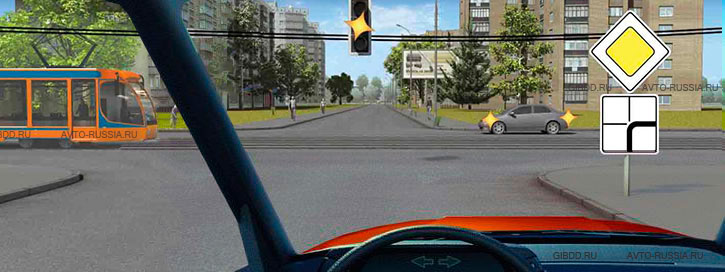
You intend to continue straight ahead. What to do when the traffic light is flashing yellow?
1. Give way to both vehicles.
2. Give way only to the tram.
3. Give way only to cars.
4. You will pass first.
When the traffic light is flashing yellow, the intersection is considered unregulated (clause 13.3), so you should be guided by priority sign 2.1 “Main Road” and sign 8.13 “Direction of the Main Road”. In this case, you should give way only to a passenger car, which, like you, is on main road and is an “interference on the right” for you (clauses 13.10 and 13.11). You have an advantage over the tram because it moves along on a minor road(clause 13.9).
Correct answer:
Give way only to cars.
Ticket 12 - Question 16
Is it allowed training ride on the motorway?
1. Allowed.
2. Allowed only in the far right lane.
Ticket 1 - Question 1
In what case will the driver make a forced stop?
1. Stopping immediately in front of pedestrian crossing to give way to a pedestrian.
2. Stopping on the roadway due to a technical malfunction of the vehicle.
3. In both of the above cases.
A forced stop means the cessation of movement of a vehicle due to its technical malfunction, the danger created by the cargo being transported, a sudden deterioration in the condition of the driver (or passenger), as well as the appearance of an obstacle on the road (a fallen load, a blockage on the road, etc.). A stop related to the need to comply with the requirement to give way is not considered as forced (clause 1.2).
Correct answer:
Stopped on the roadway due to a technical malfunction of the vehicle.
Ticket 1 - Question 2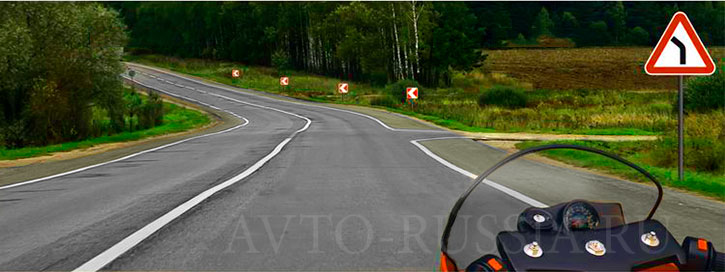
Are you allowed to drive onto a dirt road?
1. Allowed.
2. Permitted only if the vehicle is technically faulty.
Correct answer:
In all of the above cases.
Ticket 1 - Question 8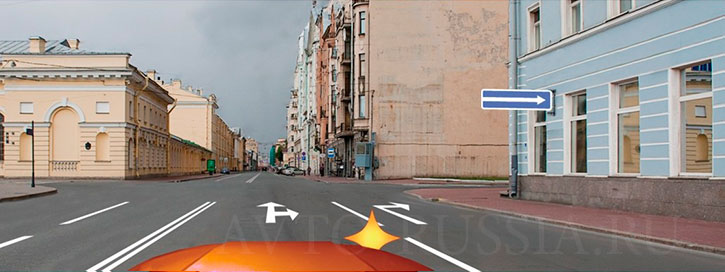
What should you do when turning right?
1. Change to the right lane, then make a turn.
2. Continue along the second lane until the intersection, then turn.
3. Both options are possible.
Correct answer:
Both options are possible.
Ticket 1 - Question 9
What trajectory are you allowed to make a turn on?
1. Only according to A.
2. Only according to B.
3. For any of the above.
When making a U-turn at this intersection, you will have to use a section of the roadway that has two-way traffic. Therefore, when entering an intersection, you can continue driving only on the right side of this section of the roadway (clause 1.4), i.e. along trajectory A.
Correct answer:
Only according to A.
Ticket 1 - Question 10
At what speed can you continue driving outside a populated area in the left lane in a passenger car?
1. No more than 50 km/h.
2. Not less than 50 km/h and not more than 70 km/h.
3. Not less than 50 km/h and not more than 90 km/h.
Correct answer:
Not less than 50 km/h and not more than 90 km/h.
Ticket 1 - Question 11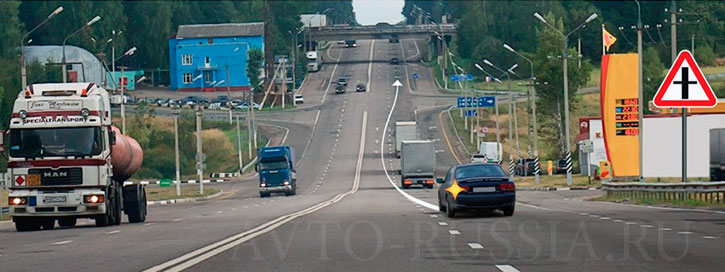
Is it possible for a passenger car driver to outrun trucks outside a populated area along such a trajectory?
2. It is possible if the speed of trucks is less than 30 km/h.
3. It is impossible.
Outside settlements Vehicle drivers should drive them as close as possible to the right edge of the roadway. However, it is possible to consistently get ahead of several vehicles following each other at a short distance. Since the driver of a passenger car is approaching an intersection of unequal roads, moving along the main road (sign 2.3.1 “Intersection with a minor road”), which has 2 lanes for traffic in in this direction, then he can get ahead of both trucks (clause 9.4).
Correct answer:
Can.
Ticket 1 - Question 12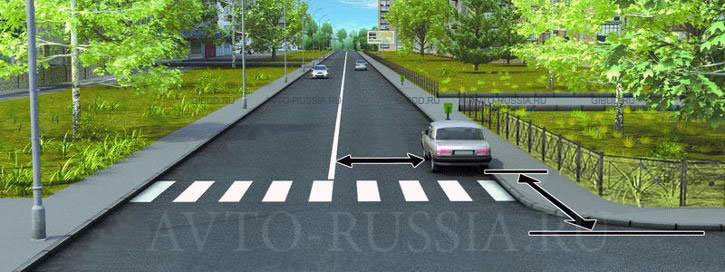
In what case is the driver allowed to park the car in the specified place?
1. Only if the distance to the solid marking line is at least 3 m.
2. Only if the distance to the edge of the crossed roadway is at least 5 m.
3. Subject to both of the above conditions.
By stopping behind a pedestrian crossing 5 m from the edge of the crossed roadway and ensuring a distance of 3 m to the continuous marking line, the driver did not violate the parking rules (clauses 12.4 and 12.5).
Correct answer:
If both of the above conditions are met.
Ticket 1 - Question 13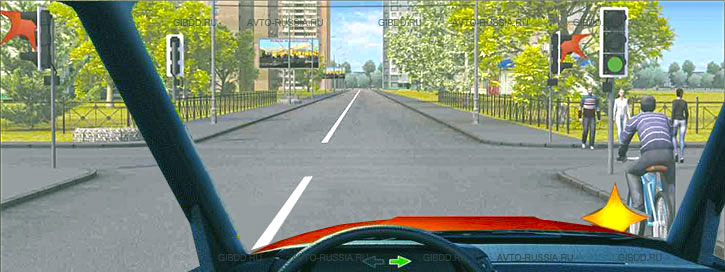
When turning right you must give way to:
1. Only for cyclists.
2. Only for pedestrians.
3. Pedestrians and cyclists.
4. No one.
When turning right at a traffic light, you must give way to both cyclists and pedestrians (clause 13.1).
Correct answer:
Pedestrians and cyclists.
Ticket 1 - Question 14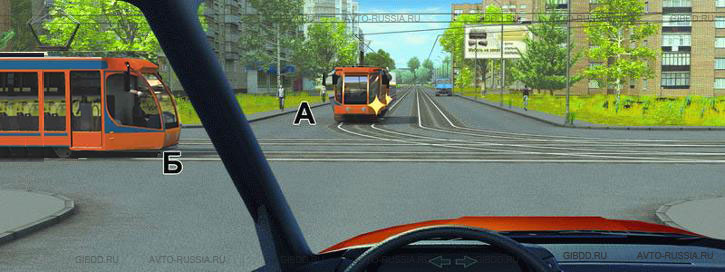
You intend to drive straight through the intersection. Who should you give way to?
1. Both trams.
2. Only tram A.
3. Only tram B.
4. No one.
In this situation, you must give way to both trams, since at the intersection of equivalent roads the tram has priority over trackless vehicles, regardless of the direction of its movement (clause 13.11).
Correct answer:
Both trams.
Ticket 1 - Question 15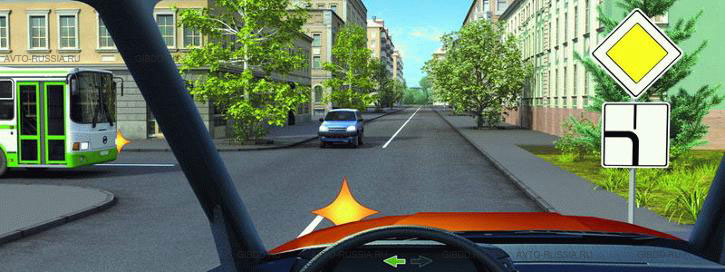
Who do you have to give way to when turning left?
1. Bus only.
2. Only for a passenger car.
3. No one.
When driving through this intersection of unequal roads in the direction of the main road (signs 2.1 “Main Road” and 8.13 “Direction of the Main Road”), you should not give way to anyone, since you take advantage of the bus located on the main road, for which you are a “nuisance.” on the right" (clauses 13.10 and 13.11), and in front of a passenger car moving on a secondary road (clause 13.9).
Correct answer:
No one.
Ticket 1 - Question 16